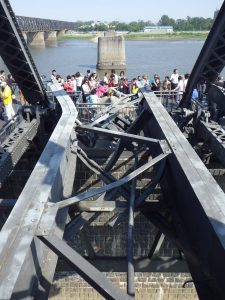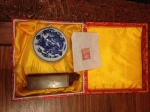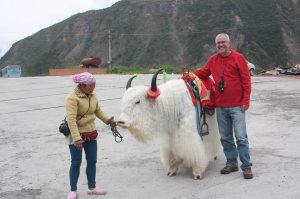(Post started on 9 June 15) This is my third trip to China in as many years. While I’ve been to many amazing places here, there are some sites I’ve visited repeatedly—a feature of traveling here with different students each time. Some of these sites are worth revisiting, and the Great Wall makes that list for me.
Yesterday I spent nearly the entire day on my feet. Five of our six students and I headed towards the mountains from the ‘farmhouse’ (really more of a bed-and-breakfast, though we take all of our meals here), looking for flowers and bees along the way.

The farmhouse
Already, just walking around the village (a sign near one entrance of town tells us that there are 352 residents) showed signs of change — new buildings going up here, a family home gone and a two-story “farmhouse” is going up in its place. Heading out of the village towards the mountains, there was more of the same. New buildings going up, new “farmhouses” open for business. Trucks, including dump trucks with only three wheels, barrel past on the narrow road — and the motorcycle-truck hybrids also pass — as well as some nicer passenger vehicles such as a Jeep SUV. (I suspected we would see this one again.) As we headed uphill, eventually the construction was behind us and only the road, trees (chestnut and walnut; cash crops), and the wall was ahead.
The trail is marked in two ways: with a sign or few saying that the path is not open to tourists and with standard trail markers to keep you on the correct path. This time, there was a third way as well: motion-activated, talking poles. Unfortunately, there was no text on them, and they spoke only in Mandarin, which no one in our group could sufficiently comprehend. As to the ‘no entry’ signs, we were originally set on this path by the proprietors of the ‘farmhouse,’ so we felt invited to use this path. (And yes, the Jeep was parked in the lot at the start of the trail.)
The hike is on a well-worn trail. It’s narrow in parts, enough so for a local to bar the way across and demand payment for access. On the bright side, he handed us three cold waters (!) once we had crossed his path. (It was also less than half of what tickets at the official tourist entry cost.) The only real rigor in it is that it heads up and up and up; no surprise as we are heading to the Wall, which runs along the ridges in the mountains here.
As to why we hike, we did stop along the way to complete observations and collect data. Interestingly, on this trip, we did not see any active bee hives anywhere we went. But—it was along this way that I stopped to investigate the telltale sign of buzzing bees, which turned out to be a large number of honeybees visiting a collection of flowering chestnut trees.

Chesnut in flower
The numbers seemed sufficient to suggest a hive nearby, but a quick hike through the area did not show any signs of the beekeepers we saw in a different part of the forest last year. We also stopped perhaps halfway up the trail to the wall and saw yet more honeybees on a patch of flowering plants. (My gut feeling is that we saw more honeybees this morning than any other, but the data have not been collated yet.) We would miss all of this had we followed the ‘official’ paths.
This time, as I made my third visit to this stretch of the Wall, I was with five students who had never seen it but for pictures. Where we gained access to it, there are views of both sides of the mountain and down into the valley from which we came, and along ridges where the Wall extends, with towers visible as far as the eye can see.

A view from the Wall

The valley from the Wall
While the initial ‘wow’ may not be what it was for me the first time I saw it, it’s little matter when I’m watching five students who are seeing it with all of that wonder and awe and more. Some things, maybe they don’t change so much…
When we exited at Mutianyu, vast changes were apparent. Where only a year ago there were stalls and hawkers to pass both entering and exiting the entrance to the Wall, there were now open paths and buildings — and a shuttle bus to an area where the vendors had clearly been moved. Vehicles were now restricted in the immediate area of the ticket office, with only the shuttle buses allowed up. This allows another ticket to be sold: for the shuttle bus.
The word that came to my mind in considering all of these changes (from Mutianyu to its sleepy neighbor Beigou) was ‘gentrification’. They seem to be ‘cleaning things up’ and ‘improving’ in ways that definitely induce change, but I’m torn as to whether the end result is better than it was. Perhaps in the long run, they are making the sites more sustainable, generating income that will be used to maintain it for the future. Forgive me if I maintain a healthy sense of skepticism as I consider that.
…

Perhaps these workers (seen last week) are restricting future access?
While I started this post the day after hiking; I’ve finished it on my fourth day back home. And a series of communications from Steven, hiking today with students from the non-research group, suggest yet more changes in just the past week: doorways that were open onto the Wall at the top of the trail last week are now closed, and someone is charging an entrance fee at this part of the wall. Last I heard, the group wasn’t paying unless tickets were issued in exchange…












Recent Comments